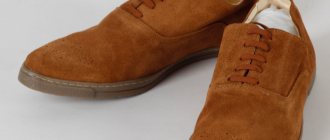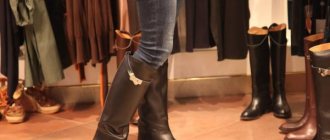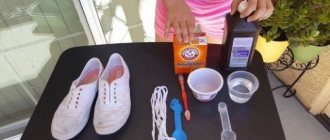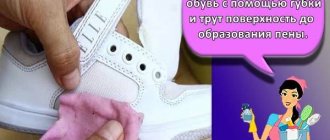Does beauty require sacrifice, as the famous “axiom” says, or have modern magicians and fighters for female beauty effortlessly found an opportunity to avoid these senseless sacrifices – or at least alleviate them?
The sweetness of the feeling of taking off your shoes after a day of work is known to every lady whose dress code does not allow her to wear slippers at work. And if flat feet, or hallus valgus, are added to uncomfortable shoes, then wearing shoes turns into real torture... For your attention - the most necessary devices for wearing shoes comfortably - and not only!
External shoe overlays and stickers
First of all, we are talking, of course, about safety and comfort.
If, as part of your job, you have to run in heels every day on smooth and slippery floors, and your overworked calves can already be the envy of athletes, and figure skaters can envy your pirouettes, then this device is for you! You no longer have to feel like a heron, balancing on a slippery floor and losing your grace in front of everyone: inexpensive Velcro stickers will save you from slipping and risking injury on a smooth floor.
The stickers are as thin as possible, have a rough surface and are firmly glued to the soles of shoes, which allows you to elegantly click on heels and stilettos at any speed - on marble floors, on wet pavement, in the subway, and at work.
What to do if leather shoes are too big?
The same as in the case of non-leather (sports, work, rubber). It just so happens that the comfort of our feet depends more on the appropriate size and cut than on the shoe material.
What to do if the shoes are big in the heels?
This question usually arises when you get shoes with too high an instep (even tightening the laces tightly does not help).
Here can help:
- soft insert in front;
- insert under the lacing or under the tongue of the boot.
In the first case, the toes will rest, the foot will move back, and the shoes will fit. In the second, the top of the shoe will adhere more tightly to the instep of the foot so that the foot is securely and comfortably fixed inside the shoe.
The insert can be made from fairly thick fabric, leather or felt, including by using several layers. You can secure it with laces, that is, for each half-pair, make two things with holes for lacing. If there is only one insert (under the tongue), it is fixed with glue.
The second option is to sew Velcro to the shoe tongue. In general, if the shoes are large in the heels, then the instep height needs to be adjusted.
Inserts for protection against calluses on heels
The most favorite places for calluses on the feet are, as you know, the heels, which are forced to suffer from any new shoes, and from old ones too, if you need to spend the whole day on your feet. Truly magical modern pads-in-ears help protect your heels from calluses.
Covering the entire heels, the inserts are made of medical silicone or eco-suede (or other safe materials), have increased softness, and do not reduce the size of the shoes.
With such inserts, new shoes are not scary, even if you have a night party, banquet or excursion ahead.
Simple tips on how to reduce your shoe size without leaving home
The following size reduction methods are suitable for any type of material your new pair is made from:
- The most basic and popular method is to insert size-reducing insoles into new shoes. As a rule, one insole is placed in each shoe, but in some cases it is necessary to insert two. Depending on the season for which the pair in need of reduction is intended, additional insoles made of foam rubber, wool or synthetics are used. This method is especially often used to shrink sneakers and other sports shoes, since in this case a shock-absorbing effect can also be achieved. In addition, soft insoles can protect the delicate skin of the feet from chafing and painful calluses;
- Another simple option is to insert a special silicone insert into each shoe or boot, which are sold in shoe stores and have a lot of varieties. In general, the purpose of such a device is somewhat different - such inserts are designed to prevent slipping and rubbing, however, they are also great for reducing the size. Unfortunately, silicone inserts cannot be used to reduce shoes whose heels are more than 7 centimeters;
- If your new shoes are falling off your feet, you can use a method often used by supermodels strutting down the runway. To do this, thick double-sided tape must be glued to the inside of the sole. This method will only be effective if you wear new shoes on bare feet. In such a situation, they will stick to your feet and will not fly off when you walk. In addition, it is not recommended to walk for a long time in boots or shoes glued to the foot in this way;
- Finally, the most primitive “old-fashioned” method is to push the required amount of cotton wool or any soft fabric into the socks of new shoes. As a last resort, you can use paper, but under no circumstances should it rub your fingers. This option is not suitable for all models - you will not be able to “squeeze” flip-flops, clogs or open-toed sandals in this way.
In addition, the Russian market presents…
- Inserts with heel fixation.
Such models also fix the heels so that they do not jump out of the shoes. - Inserts with orthopedic properties . Or corrective heel pads that fix the heels, reduce the load on the spine, and reduce pain.
- Pain-relieving lower heel inserts
- Massage, anti-callus inserts.
- Wedge-shaped silicone heel pads, which are recommended for hallux valgus or varus foot.
Thanks to their beveled shape, they provide the necessary correction for clubfoot, reduce the load on the joints, help correct hallux valgus, and in addition, extend the life of the heels, which will not wear out so quickly.
Earbuds
Shoe inserts are special devices that are placed under the forefoot, under the heel, or glued inside in any convenient place, thereby taking up some space in the shoe or boots and making them narrower or shorter. At the same time, people around will not suspect anything, because they are not visible to strangers.
This is one of the simplest and most affordable ways to return shoes to their original size and shape if they have stretched during wear. They are sold in shoe stores and are inexpensive, do not cause discomfort when worn and last quite a long time. They are easy to care for: after each “walk” you just need to take them out and dry them in the open air.
There are two types of inserts:
- silicone;
- suede (brown, beige and black).
Both are suitable for suede shoes, while suede inserts themselves are used only for similar shoes.
The thickness and size of the inserts vary, so they can be adjusted based on how big the shoes are. You should also consider the type of shoes: small inserts are suitable for shoes and sandals; for boots and shoes you can choose larger ones.
If you put the insert in shoes whose heel height exceeds 6-7 cm, the load on the foot will increase, and walking will simply be uncomfortable.
Insoles and inserts with orthopedic properties
First of all, these are modern silicone (or cork) insoles, which are pleasant and comfortable even in the hardest, most unworn and uncomfortable shoes. And not only in shoes, but in open shoes.
Orthopedic silicone insoles reliably fix women's legs, preventing them from “riding” on the main insoles of the shoes.
In addition, such insoles fix the arches of the feet in an exceptionally correct position, which is ideal for the prevention of flat feet and indispensable in the treatment of flat feet or other foot diseases.
It is important to note that silicone insoles are transparent and completely invisible in shoes; they can reduce the size of shoes (there are many options for insoles, select them taking into account the need for this criterion).
But the most important thing is that such insoles relieve stress from the feet, and therefore from the spine, eliminate leg fatigue, and allow you to move in shoes longer, further, and with greater comfort.
The instructions for the insoles are also simple - just glue them to the main insole of the shoe.
General recommendations
The buyer has the right to return or exchange shoes within 14 days after purchase, but only if the ballet shoes show no signs of wear or scratches. In addition, you are required to provide the manager with a guarantee card, passport and check. But it happens that you come across an unscrupulous seller and nothing can be done. Don’t worry – you won’t have to throw away your wide shoes, because downsizing your shoe size is quite possible.
This can be done both in the workshop and at home, but in order not to harm the sandals, follow the recommendations of specialists.
- Keep in mind that shoes often stretch in width rather than in length.
- Patent leather shoes can be made smaller, but they should only be treated from the inside.
- Leather ballet shoes can easily shrink by a few millimeters, but you need to be careful with artificial materials, as they can crack and even tear.
- Never put paper in your sock, as it causes severe discomfort while walking.
And remember that all the proposed methods will only help when the sandals are just a little too big (maximum one size).
Also among the devices with orthopedic properties for shoes are:
- Silicone pads for midfoot support.
- Silicone half-insoles with arch support function - for high-heeled sandals, sandals or other open shoes. A good option for a girl with longitudinal flat feet.
- Insoles with double arch supports located on the toes and heels.
Well-springy insoles relieve stress in the feet, and absorbent properties protect the feet from the effects of increased summer sweating. - Self-adhesive gel (or suede) instep supports specifically for open/dress shoes. Comfortable and useful for quickly fatigued legs from walking and painful sensations from wearing shoes. The arch supports are designed to be anatomically correct, which greatly alleviates the condition of flat feet.
- Special insoles with a massage effect.
- Magnetic insoles with acupuncture properties.
- Insoles that remember the relief of the foot.
Well, don’t throw it away... How to reduce shoe size using special devices?
In order not to harm your feet when wearing larger shoes, you need to “adjust” them to fit you. For this purpose, there are special “reducers” that can reduce shoes to one and a half sizes.
Full heel protection for sports shoes: minus 0.5 sizes
You ordered excellent running sneakers from abroad, but made a mistake with the size and received shoes half a size too large. During the first run, it turned out that the heel in the new sneakers was “shaking.”
Instead of exchanging the product for another and again waiting for the package to arrive, or trying to return the payment, you can simply glue these inserts into the heel of your sneakers.
They will “eat up” empty space and will cushion you when playing sports.
Absorbent pads to reduce sports shoes by 3mm
If the sneakers or sneakers do not fit you, the heel will “dangle” in them, and the heel of the shoe will rub the heel area. There is a solution - these are soft foam pads. They will reduce the size of your shoes and prevent them from rubbing your skin.
Super-absorbent inserts in the toe of sports shoes: minus 1 size
Did the store mistakenly sell you a size too many sneakers? Dont be upset! Just place these inserts in the toe part of the shoe, and then the foot will stop sliding into the toe of the sneaker, and the heel will stop “dangling.”
Set for dress shoes “toe + heel”: minus 1.5 sizes
If your favorite leather shoes have worn out and started to fall off your feet, don’t rush to say goodbye to them. This set can help you. Silicone socks, along with an insert in the heel of the shoe, will reduce the shoe by an entire size, and you can continue to wear it.
Heel pads made of genuine leather to reduce classic shoes by 4 mm
Do you love heeled shoes, but the heel keeps falling out of them? No problem! These leather inserts will delicately hold the heel in the shoe and prevent it from “breaking out” out.
Inserts in dress shoes without slipping in stockings: minus 3-4 mm
Force majeure is an unacceptable phenomenon at important events. Imagine that when preparing for a wedding, anniversary or graduation, you were in a hurry and bought a little more shoes than you needed. You don’t have to drop everything and rush to the store to exchange a pair of shoes. It is enough to glue these tabs into the heel, and you can continue preparing for the celebration.
Elastic inserts with adjustable thickness in the toe of dress shoes: minus 1-2 sizes
The thickness of these inserts can be adjusted by inserting and removing internal elements. Therefore, they will save you if your feet swell in the evening and suffer in shoes that were just right for you in the morning. The products are very easy to slide in and out of your shoes, so you won't have any trouble removing them from your sock once you feel like there's not much room left.
Soft protectors to reduce shoe instep by 2-3 mm
Have you seen this picture: a girl walking along the sidewalk in open-toe shoes, and her toes “slap” on the asphalt? To avoid repeating this mistake, wear these protectors with open-toed shoes. Dense silicone will fix the foot in the toe part of the shoe and will not allow the toes to “fall out” out.
Orthopedic pads for dress shoes “minus 1 size”
These pads are not put on the foot, but are placed under the sole of the toe. You can't even see them with your feet! They also seem to support the foot from below and prevent it from slipping forward, which means that in shoes with an open toe your toes will not “pop out” out.
Massage half-insoles to reduce the instep of dress shoes by 3 mm
In open shoes, and in particular in sandals, leather straps and constrictions can stretch during wear. Then the foot begins to “fall” forward and slide off the sole when walking. These half insoles will help you prevent this from happening. They will reduce the instep of the shoe by 3 mm and fix the foot in it.
Fabric socks to reduce open shoes by 2-3 mm, with fixation on the foot
Have you ever worn sandals in hot weather? If so, then you will remember how a wet foot “wobbles” along the sole of a shoe.
These socks will secure your foot, because they have a non-slip coating and a thick pad that will lift your foot and prevent it from “squeezing” between the strap and the insole.
And they won’t fall off your feet or slip out, because they have an invisible but reliable fastening.
Silicone pads in shoes to reduce the load on the feet
Women's legs look much more graceful in heels, no one can argue with that. But high heels, when worn for a long time, negatively affect not only the joints of the legs and spine, but also cause significant discomfort. There is no woman who would not exhale with relief when she kicks off her shoes at home and climbs into her slippers.
Silicone pads will help reduce the load, relieve foot fatigue, make wearing shoes with heels more comfortable, and provide high-quality shock absorption even in hard office shoes . Many girls probably already have such magical pads, transparent and unnoticeable (and more than one pair).
A few tricks to reduce your shoe size
One of the easiest ways is to take a pair to a workshop, where they will do this task perfectly. But shoemakers most often do not take on sneakers, boots and shoes made of leatherette or woven materials. You also need to take into account that this can cost a pretty penny. If you have time and desire, you can reduce the size using additional materials.
- Insoles are one of the simple ways to reduce not only the size, but also the volume of shoes. When one insoles are not enough, you can use two. The material from which the insoles are made is chosen depending on the time of year. For a winter pair of shoes, fur, felt or wool insoles are suitable. For demi-season boots, foam or synthetic insoles are usually used. If the insoles are intended for sports shoes, then they will reduce the size of the sneakers and have a shock-absorbing effect.
- Silicone inlays - can be purchased at almost any shoe store. Initially, they are intended to prevent slipping and rubbing of calluses. But they are also capable of narrowing the shoes a little. But to make high-heeled shoes smaller, it is better not to use them.
- Double-sided tape - you can stick it on the inside of the sole of the shoes, but you need to put them on bare feet, otherwise the tape will not stick. This method is mainly used by models during shows. Walking in such shoes for a long time is uncomfortable.
- Cotton wool, paper or fabric - placed in socks, it will help make shoes a size smaller. Our mothers and grandmothers also used this method, because back then they often bought shoes for children to grow into, or they got them from older brothers or sisters. But you need to keep in mind that this method is only suitable for closed-toed shoes.
On a note!
Shock-absorbing orthopedic insoles are considered a good size reducer for closed shoes.
But not everyone knows that there are still...
- Silicone inserts that prevent flat feet and hallux valgus.
They secure the foot, provide shock absorption, improve blood circulation and even have a slight massage effect on the forefoot. - Special pads for sandals/flip-flops with an interdigital partition.
There is no need to cut up classic silicone pads - buy ready-made pads that are attached to the jumper. - Inserts made of medical silicone with instep supports.
These pads for shoes and sandals have orthopedic and massage properties, shock absorption and moisture absorption. In addition, they protect the feet from deformation, relieve tension in the calves and “breathe”.
Silicone stickers for straps on shoes and sandals
Straps on new shoes and sandals always add grace, but narrow and stiff strips of leather (or other) straps are always a new peeve.
However, in this case, manufacturers have already come up with a life-saving remedy. Namely, silicone stickers on narrow straps that prevent the straps from digging into the skin and rubbing calluses.
Like silicone inserts, these strips have an adhesive backing that provides a tight and secure fit on the inside of the straps.
Ways to reduce shoe size
Additional insoles
Insert an additional insole into a large pair of shoes (and, if necessary, two), which should be selected depending on the type of shoe that needs to be adjusted in size: foam rubber, synthetic or wool. If you insert additional insoles into sneakers, you will also get a shock-absorbing effect, and lovers of ballet shoes will like this shoe accessory because the soles will be reliably protected from chafing.
Old-fashioned method
If the shoes suit you in volume, but are slightly too long, you can use the old proven method: push soft fabric or cotton wool into the toes of the shoes. Plain paper is also suitable for such purposes, but it must be very soft to prevent rubbing of your fingers.
Unfortunately, such a simple and reliable method is applicable only to closed-toe shoes. The size of fashionable summer models with cutouts above the big toe and open sandals cannot be adjusted in this way.
Compression due to temperature changes
Wet the inside of the shoes thoroughly, using a spray bottle of water for this purpose, and place them to dry close to the radiator or heater. Almost any shoe will shrink from such a sharp temperature change, but there is a high probability that the beautiful surface of the product will deteriorate. This “harmful” technique should be used only in cases where you are ready for completely unexpected results.
An even more risky option: put on shoes that have become too loose and put your feet in a basin filled with water. Sit like this for a short time, and then place the shoes on the radiator or dry them.
Silicone Tabs
In shoe store windows you can often find small silicone inserts designed for different types of shoes. Their shape and size should be chosen depending on the places in which they will be placed in the future. The direct purpose of such liners is to prevent chafing and slipping, but they can also be used in our case - to fill empty spaces, thereby reducing the size of the shoe.
Very often, models showing clothes on the catwalk suffer from discrepancies in shoe sizes. For them, big shoes are a real problem, since they have to walk on the catwalk in such shoes. It turns out that the models have their own secret: you just need to stick good quality double-sided tape on the inside of the shoe sole. This way, the shoes or sandals will stick to your bare feet and will not fly off while walking.
Method for reducing leather shoes
You can reduce the size of leather shoes and slightly narrow their toes by briefly holding them in a basin of hot water, after dissolving washing powder in it. Then the shoes must be dried in the sun or near heating devices. To make it easier for the skin to endure such an extreme procedure, you need to spray already dry and narrowed shoes with a special product and walk around the house in them a little. This will soften the leather a little and will fit perfectly on the leg.
We reduce summer shoes in the workshop
Shoes such as flip-flops, clogs and open-toed sandals should be reduced in size by a professional. In the workshop, the thin straps will be carefully separated from the sole part and slightly shortened, or perhaps simply sewn in closer to the middle. After such simple manipulations, shoes will fit much more tightly on your feet.
You should not try to implement a similar method at home. To sew thick soles, you need a special machine, which there is no point in buying, but a shoemaker always has it at hand. Of course, you can try at home not to sew, but to glue the straps of the top of the product to its sole, but even the best glue cannot guarantee the necessary durability and strength.
For some, this is just a way to protect their feet from the negative influence of the environment, for some it is a technique for self-expression, and for a number of consumers it is even an indicator of the status of the owner. And all this is about one thing - about shoes. Moreover, men and women of different ages have at least once been faced with the fact that the purchase of a beautiful pair has already been made, but it is impossible to wear: the size is too large. So what should we do? Return it to the store (and if you bought it second-hand, what then?), give it to a friend (and be jealous, imagining yourself in his place) or try to deal with the problem at home? Let's choose the latter and see if we can reduce the volume and size. Moreover, sometimes shoes simply wear out and become too big, so the first two solutions certainly won’t work.
Modern followers and traces: not only “for grandmothers”!
Among the main functions of footwear and footwear are hygiene (without them you won’t be allowed to try on shoes in a store), protecting your feet from calluses and blisters, as well as “disguising” an old pedicure that you haven’t had time to fix.
Of course, modern manufacturers no longer offer only those “grandmother’s” footprints that stick out from the summer slippers and shoes of most pensioners. Modern heirlooms can be a real work of art, and they are not only not hidden, but even put on display!
Reviews
Anna
I once bought shoes on sale. The store thought they were absolutely delicious and inexpensive. I came home and tried them on, it turned out that they were too wide for me, I was very upset and was already thinking about taking them back, but a friend advised me to wet them with water and then dry them. I was afraid at first, but then I finally decided to try. As it turned out, I worried in vain, everything worked out and they fit like a glove.
Regina
After two years of wear, my autumn suede boots stretched out at the shins and looked ugly on my feet. I decided to restore their previous shape, I sprayed the tops with a spray bottle, and then dried them with a hairdryer. Of course, they did not tighten completely, but the width decreased, I decided that I would not experiment a second time, I would repeat the procedure if I stretched again.
Followers can...
- Completely cover the entire foot (like sports low socks).
- Cover the entire foot except the toe.
- Cover the entire foot except the heel.
- Cover only the toe (like choreographic shoes with elastic bands).
- Cover only the area between the toe and the middle of the foot. Such models of footwear in the form of narrow stripes are very popular among girls wearing new sandals. If the material rubs and the sandals are not worn in, then invisible marks hidden from view will be a real salvation.
Myth or reality
Large shoes are good only in childhood for playing mother-daughter games, but in adult life this problem causes a lot of inconvenience
First you need to find out what characteristics the pair does not fit in size. First, shoes can be longer than your feet. Second: the shoes may not fit the width of your feet. So, is it possible to make your downsizing dream a reality? Of course yes. Moreover, there are even 2 approaches for this.
- Contact the workshop. Professionals will use full or partial constriction, that is, they will separate the heel and sole, and attach the upper to the last of the required size. This is if the shoes are not the right length. If the pair is wide, they will sew it up or choose another way to solve the problem.
This is interesting. Not all shoemakers will take on a non-leather pair, much less sneakers or sneakers that have a special cut. But sandals, clogs or flip-flops can only be narrowed in a workshop, where the straps are carefully stripped, shortened and sewn into place.
- Try to use folk wisdom. This is where there are no restrictions on the quality of shoes. Only according to the material, although there are methods suitable for all types. Let's start with them.
Modern followers are...
- With silicone relief (pimples, stripes, etc.) on the bottom so that the foot does not slip in the shoe.
- Any color, pattern and texture.
- With pads that reduce pain and fatigue in the legs and increase shock absorption.
- With absorbent effect.
- Openwork-lace and “mesh”».
- Fantasy, colorful with various decor.
Shock-absorbing insoles for high-heeled shoes
Silicone shock-absorbing insoles, as the name implies, serve primarily to cushion and absorb shock when moving due to the air cushion inside.
These insoles can be selected for shoes with heels of any height. The ultra-soft material will reduce pressure on the heel and ball of the foot, and thanks to the translucency, they can even be worn in open shoes.
Among the models of such insoles you can also find…
- Insoles that raise your heels - and the legs of a lover of flat shoes are shown more advantageously.
- Massage shock-absorbing insoles , which will not only relieve stress and provide softness, but also stimulate all the necessary points on the feet.
- Special heel pads. Most often they are used by athletes, but they also have their own comfortable and discreet heel pads for running around the office.
Big Toe Covers/Braces
According to statistics, every second girl is familiar with the problem of bunions. And in a situation where the big toe is bent and Hallux Valgus occurs, special overlays come to the rescue, allowing you to not interrupt the correction even in the summer, when wearing shoes. Silicone clamps allow you to protect the joint from excessive friction, as well as correct its position and gradually correct and reduce the curvature of the thumb.
Bursoprotectors with interdigital partitions are also available on the market. Unlike clamps, they are worn on 1-2 fingers.
The situation will be corrected with a “light movement of the hand”...
- Thin insoles with antibacterial spray coating, absorbing unpleasant odors.
There are models that also have shock-absorbing properties. - Breathable perforated insoles, made on the basis of a powerful absorbent and from high-quality eco-material.
- Insoles with deodorizing effect.
Protective silicone caps for fingers
Such finger pads made of soft gel material reliably protect the delicate skin of the fingers from calluses, chafing and damage. An ideal option if your skin is too dry and painfully cracks between your fingers, as well as if you have calluses that cause pain when you rub one finger against another.
Toe caps are completely invisible in shoes and are almost invisible when wearing sandals due to their transparency. The cap is suitable for any finger - except for the thumb, which, of course, needs its own finger cap in size.
The site Colady.ru thanks you for your attention to the article - we hope that it was useful to you. Please share your feedback and tips with our readers!
Useful tips
If for some reason the pair could not be taken to the workshop or the shoemaker did not take up the work, then recommendations for reducing shoes at home will help. First, you need to understand exactly what parameters it is not suitable for, length, width or height, and only then get to work. You also need to consider what material it is made of.
How to reduce your boot size
When exposed to moisture, the skin can stretch. Even the size of the boots you buy can become too big after a while. As the leather dries, it tightens, this property will help reduce the size and fullness of the boots. You can remove worn-out shoes at home using a paraffin candle and a hairdryer; as consumables you will need a piece of soft material and paper.
Algorithm of actions:
- The boots need to be shaped; to do this, they are stuffed with newspaper or paper.
- Rub socks with paraffin.
- Turn on the hairdryer and heat until the paraffin is completely absorbed.
- Remove wax residues with a cloth.
- After cooling, try on the boots; if there is a need to shrink them further, you need to repeat the procedure.
How to make suede shoes smaller
Suede, like leather, contracts when exposed to temperatures, but the results can be unpredictable. It is possible that a pair of shoes will lose their beauty. Therefore, to narrow or reduce the size of suede shoes, it is better to contact a specialist. But you can try to seat them yourself. To do this, one by one, the products need to be held over steam, and then placed in the freezer. In the case of patent leather shoes or boots, it is also better to contact a specialist.
How to reduce the size of sneakers or sneakers
In sports shoes, an additional insole is most often placed and laced tightly; if this does not help, cotton wool or soft fabric is placed in the sock. Fabric products can be washed in water at a temperature of 60-90 degrees, but you need to take into account the quality of the fabric, it can fade. When washed, the fabric shrinks a little, but when worn, the sneakers will regain their original shape.
How to reduce your sandal size
Downsizing summer leather shoes is a little more difficult. After all, it is basically open-type and the inserts will attract attention. To make your sandals less worn out, you can shorten the straps. In the case of expensive shoes, it is better to contact a qualified specialist, but many prefer to deal with the problem themselves.
To reduce the length of the straps you will need:
- sharpened scissors;
- screwdriver;
- high-quality glue;
- brush;
- high power hair dryer;
- sandpaper;
Regular straps without patterns or decorations are cut on one side. If they have any decorative elements, the length is reduced on both sides. First, use a screwdriver to separate the strap from the sole and insole. Use sandpaper to remove glue from the sole and straps. Measure out the required length, and use a brush to apply a small amount of glue to the places where the sole and straps are glued. Wait 20 minutes and apply another layer of glue. Afterwards, use a hairdryer to heat the surfaces on which the glue is applied and install the straps in place, pressing them tightly.
On a note!
The method is suitable for sandals made of any materials.
How to narrow the tops of boots
Many people are faced with the problem of wide tops on boots, even if the size is just right. In this case, you can take the boots to a professional, or sew stretch marks on the inside. If you have a sewing machine and sewing skills in the house, then you can simply stitch up the fold located at the back. If the boots are leather, you can wet the tops and then dry them with a hairdryer.










